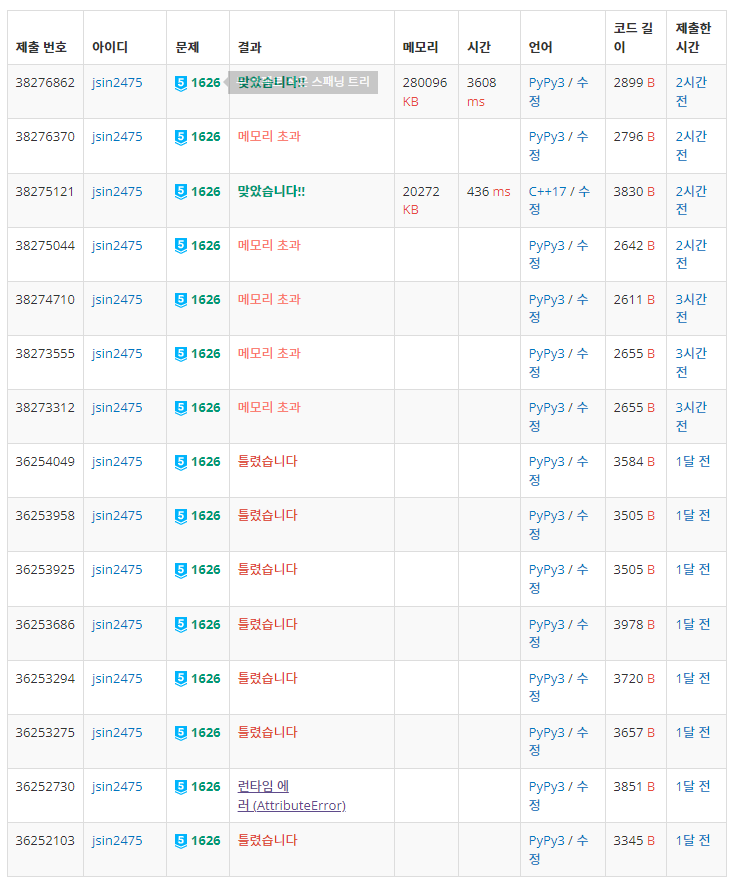https://www.acmicpc.net/problem/1626
시간 2초, 메모리 128MB
input :
- V E(1 ≤ V ≤ 50,000, 1 ≤ E ≤ 200,000)
- u v w(0 <= w < 100,000)
output :
-
두 번째로 작은 스패닝 트리의 값을 출력
-
스패닝 트리나 두 번째로 작은 스패닝 트리가 존재하지 않는다면 -1을 출력
기본적인 아이디어는 BOJ 15481 그래프와 MST
의 간선들 중 최댓값을 가져오는 것을 응용해야 한다.
가장 큰 차이점으로는 트리가 존재하지 않을 수도 있다는 것이다.
제한
- 스패닝 트리의 존재여부
- 두 번째로 작은 스패닝 트리의 존재여부
1번의 경우에는 MST의 간선의 개수로 체크할 수 있다.
중요한 것은 2번이다. 이루고 있는 간선들 중 가장 큰 값을 찾고, 새로운 간선을 추가하는데 값이 동일한 경우가 있을 수 있다.
그런 경우에는 2번쨰로 작은 간선을 찾아두고 이 경우도 체크를 해야 한다.
다음 풀이
- MST 제작
- 연결되어 있는 간선 제외 하고 MST를 찾기
이전과 동일하게 크루스칼 + union-find를 통해 MST 제작.
이거도 결국에는 특정 노드 두개가 이루는 사이클 중, 가장 값이 큰 놈을 찾아야 함.
그렇기에 LCA를 사용해서 더 빠르게 체킹을 함.
그러나, 이 문제에서는 2개의 간선을 저장해야 해서 lca 노드, lca 간선을 저장 하는 두 개의 다른 배열을 가지도록 하는 방법도 좋음.
longest라는 함수를 만들어서, lca를 돌면서 체킹할 때도 이를 사용할 수 있다.
lca 돌 때 마지막에는 해당하는 노드가 찾을 게 2개라서 이걸 2번 체킹하면 된다.
추가
DFS보다 BFS를 사용하는 방안이 메모리를 조금 덜 사용하는 것 같음. 다른 부분들도 코드를 고쳤지만 이 탐색 방법을 바꾼 것이 가장 유효한듯함.
쓰레드가 덜 생겨서 그렇지 않을까 싶음.
import sys
from math import log2
from collections import deque
def find(node):
if parent[node] != node:
parent[node] = find(parent[node])
return parent[node]
def union(a, b):
parent_a = find(a)
parent_b = find(b)
if parent_a > parent_b:
parent[parent_a] = parent_b
else:
parent[parent_b] = parent_a
def bfs():
depth[0] = 0
q = deque([0])
while q:
node = q.popleft()
for next_node, cost in graph[node]:
if depth[next_node] != -1:
continue
depth[next_node] = depth[node] + 1
parent[next_node][0] = node
two_weight[next_node][0] = [cost, -1]
q.append(next_node)
def longest(arr1, arr2):
temp = list(set(arr1 + arr2))
temp.sort(reverse=True)
while len(temp) < 2:
temp.append(-1)
temp = temp[:2]
return temp
def set_parent():
bfs()
for log in range(1, k):
for node in range(1, v):
next_node = parent[node][log - 1]
parent[node][log] = parent[next_node][log - 1]
weight1, weight2 = two_weight[node][log - 1], two_weight[next_node][log - 1]
two_weight[node][log] = longest(weight1, weight2)
def lca(a, b):
ret = [-1, -1]
if depth[a] > depth[b]:
a, b = b, a
for log in range(k - 1, -1, -1):
if depth[b] - depth[a] >= (1 << log):
ret = longest(ret, two_weight[b][log])
b = parent[b][log]
if a == b:
return ret
for log in range(k - 1, -1, -1):
if parent[b][log] != parent[a][log]:
ret = longest(ret, two_weight[a][log])
ret = longest(ret, two_weight[b][log])
b = parent[b][log]
a = parent[a][log]
ret = longest(ret, two_weight[a][0])
ret = longest(ret, two_weight[b][0])
return ret
v, e = map(int, sys.stdin.readline().split())
edge, graph, used = [], [[] for i in range(v)], [0] * e
parent = [i for i in range(v)]
for i in range(e):
a, b, c = map(int, sys.stdin.readline().split())
a -= 1
b -= 1
edge.append((c, a, b))
edge.sort()
mst, cnt = 0, 0
for i in range(e):
c, a, b = edge[i]
if find(a) != find(b):
union(a, b)
graph[a].append((b, c))
graph[b].append((a, c))
used[i] = 1
mst += c
cnt += 1
if cnt != v - 1:
print(-1)
exit(0)
ans, k = float("inf"), int(log2(v)) + 1
depth, two_weight = [-1] * v, [[[-1, -1] for _ in range(k)] for _ in range(v)]
parent = [[-1] * k for i in range(v)]
set_parent()
for i in range(e):
if used[i]:
continue
w, u, v = edge[i]
weight = lca(u, v)
if weight[0] != w:
ans = min(ans, mst - weight[0] + w)
elif weight[1] != w and weight[1] != -1:
ans = min(ans, mst - weight[1] + w)
if ans == float("inf"):
print(-1)
exit(0)
print(ans)
시간을 많이 사용하긴 했지만, 풀어서 기분은 좋다.
드디어 2학년 2하기 알고리즘의 굴레에서 벗어난 느낌이다.
